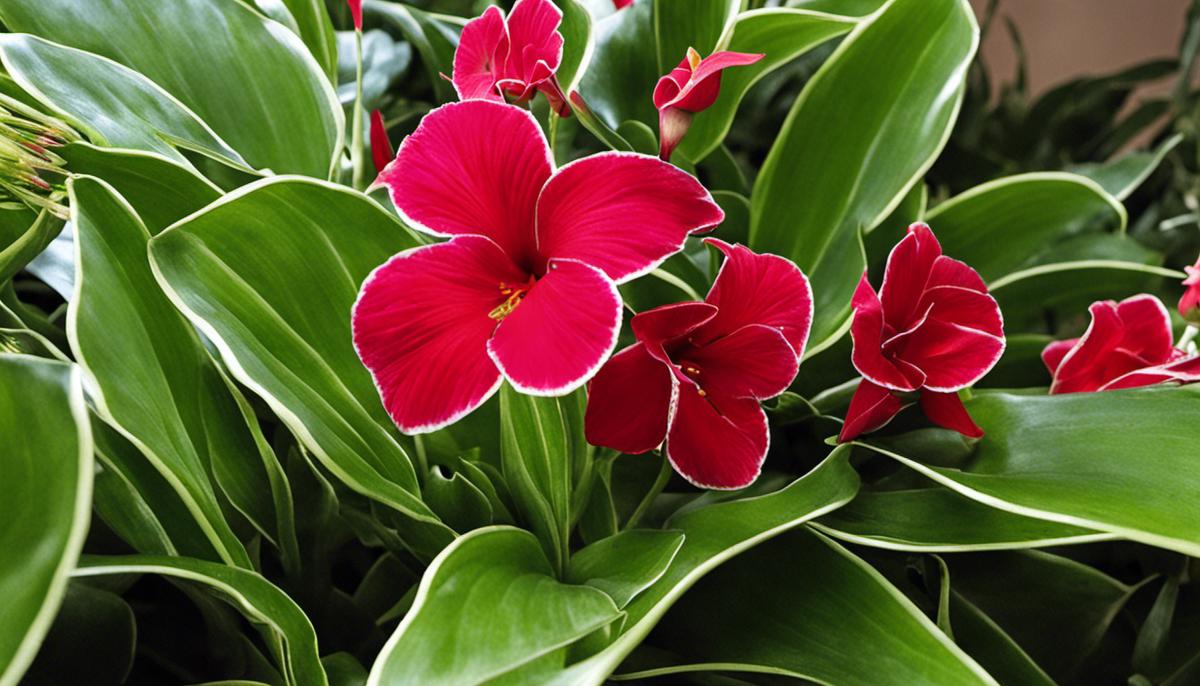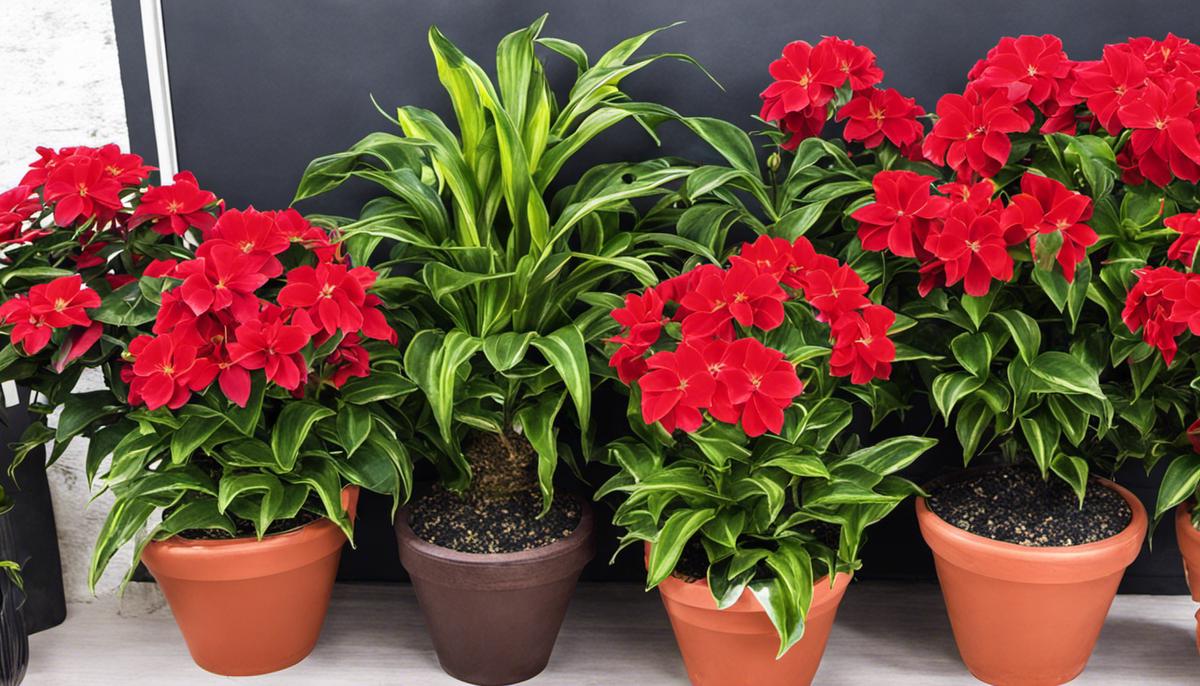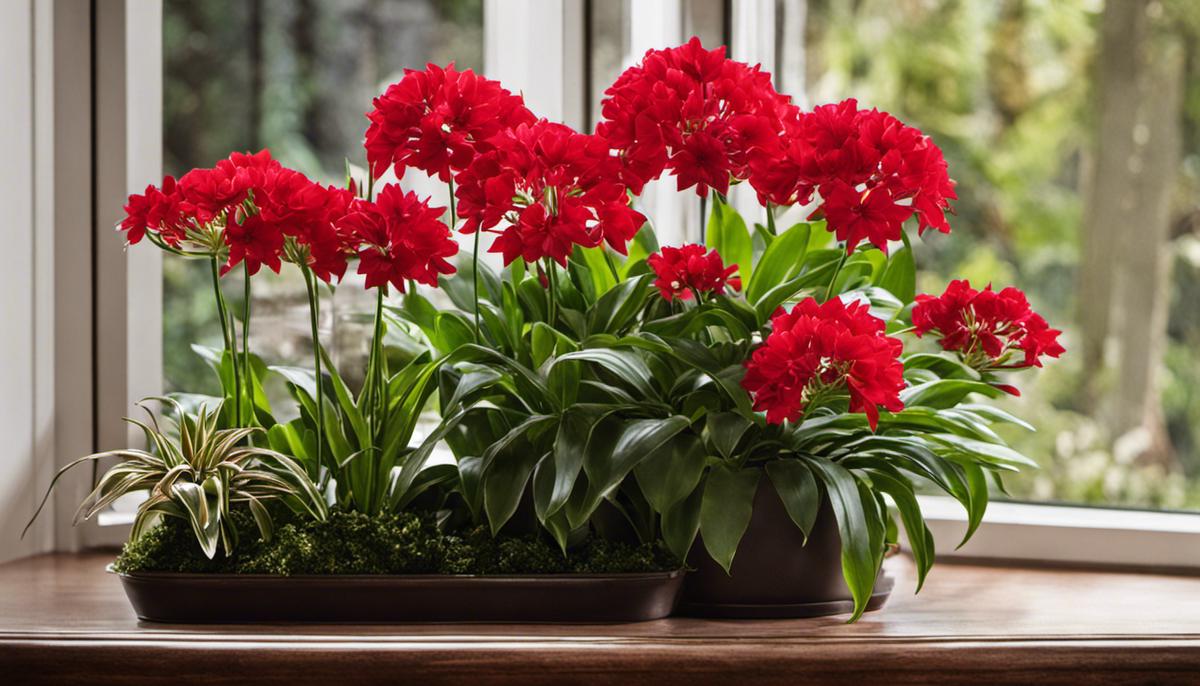Welcoming the vibrant charm of red flowering indoor plants into your home can rewrite your setting’s aesthetic and mood. Known for their enchanting scarlet blossoms, these delightful plants are a stunning addition to any indoor collection. This piece intends to give you a comprehensive understanding of these beautiful indoor delights, right from their unique characteristics to tips for their care and maintenance. We will delve into their botanical names, origins, growth patterns, and lifespan, as well as their needs for light, temperature, water, and soil. Gaining a richer knowledge about these plants will ensure you can care for them in a way that promotes blooming and maintains their captivating red hues.
Understanding Red Flowering Indoor Plants
Common Types of Red Flowering Indoor Plants
One of the popular choices is the Anthurium, also known as the Flamingo Flower, which is indigenous to Central and South America. Anthuriums are beautiful flowering plants that can grow up to 3 feet tall and offer a year-round blooming cycle. Due to its tropical origin, it prefers a warm, humid environment and bright, indirect sunlight.
The African Violets (Saintpaulia) with red blooms are another common household indoor plant, smaller in size, typically measuring 2 to 12 inches in height. African Violets are known for their velvety, heart-shaped leaves and strikingly bright red flowers. They prefer high humidity and should not be watered directly into the leaves as it can cause leaf spots.
Then, the Amaryllis (Hippeastrum) is a more dramatic red flowering option due to their large, illustrious blooms. Native to Peru and South Africa, Amaryllis can grow between 20 to 60 centimeters tall. Their blooming periods are often around the holiday season, making them a popular winter indoor plant. They require indirect sunlight and well-drained soil as they are vulnerable to root rot.
Significance of Red Flowers
Red flowers are often associated with love, passion, and energy. They are captivating due to their vivid, warm hues attracting not just individuals but also pollinators in the wild. This makes them a popular choice for indoor decor, adding a pop of color and brightness to your space.
Growing Requirements for Red Flowering Indoor Plants
Red flowering indoor plants have a variety of growing conditions depending on their origin and growth patterns. However, they generally love bright but indirect sunlight, as direct sunlight can burn the leaves and fade the color of the flowers.
Humidity is another common requirement for these plants, mimicking their native tropical environments. Regular misting or placing a tray of water near the plant can help maintain the needed humidity for these plants.
Red flowering plants usually prefer well-draining soil and watering only when the topsoil is dry, as overwatering can cause root rot. These plants have a variety of fertilizing needs: some need regular feeding during the growing season (spring and summer) while others only need occasional feeding.
Understanding the Lifespan of Red Flowering Indoor Plants
The longevity of red flowering indoor plants can greatly differ, relying heavily on their care and environment. For example, with the right nurturing, an Anthurium flower can flourish for an extended period. In contrast, African Violets tend to survive for just a few years even when cared for optimally, necessitating successive replacements. Alternatively, the lifespan of an Amaryllis plant, with appropriate care, can extend beyond 75 years, often becoming a cherished family heirloom.

Caring for Red Flowering Indoor Plants
Making An Informed Choice for Your Red Flowering Indoor Plants
Certain well-liked selections of red flowering indoor plants include Anthuriums, Begonias and Bromeliads. Every variety has its specific care requirements, although most share common necessities like moderate light and balanced conditions. They generally prefer an environment that’s not too extreme — neither excessively hot nor cold, nor too damp or dry.
Light Requirements
Most red flowering indoor plants prefer bright, indirect light. Avoid placing them in direct sunlight as it can scorch the leaves and damage the flowers. However, too little light can hinder blossom growth. An eastern or northern facing windowsill is often a good location.
Temperature and Humidity
Red flowering indoor plants typically thrive in temperatures of 65-75°F during the day and around 55-60°F at night. Any drastic changes can harm the plants. Many species also like humidity so consider placing a shallow tray of water near the plant or mist lightly to increase the moisture in the surrounding air.
Watering and Fertilizing
Water requirements vary among different red flowering indoor plants, but as a general rule, the soil should be kept moist but not soaked. Over-watering can cause root rot, which leads to a decline in plant health. Fertilizing can prove beneficial for red flowering plants to enhance bloom production. Use a balanced houseplant fertilizer and follow the directions on the packaging for correct dosages.
Promoting Blooming
Red indoor plants benefit from regular but minimal pruning to help stimulate flower production. Pinch back leggy growth and remove old, faded, or dead leaves to aid overall plant health. Some plants, like Anthuriums, can rebloom if they are allowed a rest period of fewer waterings and no fertilization for a few weeks.
Soil Requirements
Most red flowering indoor plants enjoy well-draining soil. Use a high-quality indoor potting mix, often enriched with peat moss, perlite, or vermiculite. Ensure the plant pot has enough drainage holes to prevent waterlogged soil.
Dealing with Illnesses and Pests
Pests such as mealybugs, aphids, or spider mites can afflict these red beauties. Inspect regularly for signs of these insects or for leaf discoloration, another disease indicator. Remove infected leaves and treat with an insecticidal soap or a homemade mix of water and mild dish soap. Preventative care, including regular cleaning of the leaves and avoid overcrowding, can help prevent many issues.
Propagation
Many red flowering houseplants can be propagated via stem cuttings, taken during pruning sessions. Place the cuttings in a glass of water until they develop roots, then transfer them to pots. This way, you can have a constant supply of these beautiful plants to brighten up your indoor spaces.
It’s important to note that each plant comes with its own unique set of needs and it might take a bit of experimenting to find out what works best for each variety. By taking the time to observe the needs of these red flowering plants, you can create a thriving environment that not only enhances the health of the plants but also brings you satisfaction in caring for them.

Top Red Flowering Indoor Plants
Anthuriums
For instance, Anthuriums are eye-catching indoor plants that boast of glossy leaves and vibrant, heart-shaped blossoms. While they are available in several color variants, the red Anthuriums are particularly appreciated for their radiant hue. These plants can grow up to 1.5 feet in height, and they prefer environments with bright, indirect sunlight. Anthuriums bloom all year round, with each flower able to keep its attractiveness for up to eight weeks.
When it comes to taking care of Anthuriums, consistency is key. Keep the temperature steady, ideally between 70 to 85 degrees Fahrenheit, and ensure a relative humidity above 50%. Water the plant when the top layer of soil starts to feel dry, but be cautious not to overwater. Display these plants on tables or counters where they can serve as lively bursts of color in your home.
Begonias
Begonias are delightful indoor plants that produce very attractive, red flowers. These plants can grow up to 18 inches tall and are known for their waxy, heart-shaped leaves and free-flowering habit. They have a consistent bloom time throughout summer and winter seasons.
Take care of Begonias by providing bright, indirect light and temperatures between 60 to 75 degrees Fahrenheit. Water them thoroughly when the top inch of soil feels dry. Keep them in well-draining pots and avoid overwatering as it can lead to root rot. They are perfect accompaniments for windowsill decor.
Christmas Cactus
Christmas Cactus is an endearing indoor plant that produces distinct crimson red flowers. It’s a fast-growing plant that can reach up to 2 feet tall. The flowers typically bloom around Christmas time, hence its name, but can also occasionally bloom during spring.
For optimal care, position the Christmas Cactus in a place with bright but indirect light. It prefers cooler temperatures ranging between 60 to 70 degrees Fahrenheit during its growing season and slightly cooler during its rest period. Water this plant thoroughly and allow the top half of the soil to dry before watering again. This plant can be the star attraction of mantel pieces or coffee tables during the holiday season.
Red Peace Lily
One such plant that stands out in the realm of red flowering indoor plants is the Red Peace Lily. With vibrant red flowers that dramatically contrast with its dark, glossy green leaves, this plant exudes elegance effortlessly. It is known to reach heights of up to 20 inches and typically bursts into bloom during the late winter to early spring.
Enhancing its appeal is its uncomplicated care routine. To keep a Red Peace Lily thriving, ensure it has access to bright, indirect sunlight and its environment has a temperature range of 65 to 80 degrees Fahrenheit. The soil should be allowed to dry between watering and the humidity set at a higher level. Be wary not to expose it to direct sunlight as this can damage its deep green leaves. Its compact size makes it ideal for desktop presentations or as a stunning display on tabletops.

Propagation and Repotting of Red Flowering Indoor Plants
Propagating and Repotting Red Flowering Indoor Plants
With appropriate care, many red flowering indoor plants, such as the Anthurium, Begonia, and Bromeliads, can be propagated either through cuttings or seed collection.
If collecting a cutting, ensure you cut from a healthy plant, aiming for a length between 3 to 6 inches with a couple of leaves and nodes. Directly place the cut into a well-draining soil-filled pot or a water container. If choosing to plant in soil, keep it consistently moist until rooting occurs.
Seed propagation requires a bit more effort. One can harvest seeds from the ripe fruits of the plant. After drying these seeds, place them on the surface of a damp, soil-filled tray, and maintain the moisture until germination begins.
Another alternative is plant division. As these red flowering indoor plants mature, they need to be divided during repotting so they can continue to thrive. While doing so, the roots should be carefully divided into sections, ensuring that each section has a viable bud that can grow into a new plant.
Understanding When and How to Repot Your Red Flowering Indoor Plants
The best time to repot your flourishing red flowering indoor plants would be during the spring season. This is when the plant embarks on its cycle of vigorous growth. Repotting in spring enables the plant to spread its roots and adjust to its new environment during its growth period.
You’ll know it’s time to repot if you see roots peeking through the drainage holes or protruding from the surface of the soil. If the plant seems overly top-heavy or if its growth has slowed despite proper care, it may be time to switch to a larger pot.
When it’s time to repot, start by thoroughly watering the plant before removing it from the old pot. While gently pulling the plant out, turn the pot. Once you’ve succeeded, trim off any dead or overgrown roots. Once you’re ready with a fresh pot filled with new potting mix, make sure there is enough space for the plant.
Secure the plant in the new pot with potting mix and then water it well. Avoid placing your repotted plant in direct sunlight immediately as it needs time to recover from the shock of transplantation. Instead, provide it indirect light and handle it with care during this period.
Adhere to these guidelines to ensure your indoor red flowering plant thrives after repotting.

Benefits of Having Red Flowering Indoor Plants
The Multiple Benefits of Keeping Red Flowering Indoor Plants
Red flowering indoor plants offer a wealth of benefits: some physically palpable and others less tangible. At the most basic level, these plants improve indoor air quality. With their photosynthetic activities, these plants absorb carbon dioxide and release oxygen, purifying the air we breathe and making it healthier and cleaner. This essentially makes indoor plants natural air purifiers, helping to rid the air of toxins and pollutants.
Another tangible advantage of having these red flowering indoor plants inside is that they release moisture into the air. In dry climates or during the winter months when heating systems dry out the indoor air, this added humidity can be beneficial. It can help alleviate dry skin, dry eyes, or a sore throat, and it can also be conducive to the health of other indoor plants, contributing to a more vibrant indoor garden.
When it comes to less noticeable benefits, these red flowering plants significantly enhance the aesthetic appeal of any room. A strategically placed plant adorned with beautiful red blooms can certainly brighten up a seemingly lifeless corner, add a dynamic texture to a room, and serve as a natural decorative element. The vibrant color of the blossoms can perfectly contrast neutral color schemes, creating a connection with nature within an indoor space.
Beyond their good looks, these plants can promote joy and positivity. Research suggests that interaction with indoor plants can help reduce stress, enhance productivity, and improve mood. The combination of fresh greenery and striking red flowers can foster a peaceful and productivity-enhancing ambiance, be it at home or a corporate office.
Finally, taking care of an indoor plant can give you a wonderful sense of accomplishment. Watching a plant you’ve nurtured bloom and thrive can be extremely satisfying. Red flowering plants, with their dramatic blooms, offer a visual treat that regularly reinforces this sense of satisfaction.
To summarize, adding red flowering indoor plants to your space provides benefits beyond mere aesthetics. They purify the air, increase humidity, promote happiness and productivity, and provide a sense of accomplishment, proving them to be exceptional additions to any indoor area. So, irrespective of whether you’re an experienced indoor gardener or just starting out with indoor plants, red flowering indoor plants can greatly improve not only your indoor decor but also your overall mental and physical well-being.

As we’ve journeyed through the fascinating world of red flowering indoor plants, we’ve seen their extraordinary characteristics, learned about their optimal care requirements, and taken a look at some of the best confetti of red that you can add to your indoor garden. Alongside the bright splash of color they bring, these plants also enhance your indoor environment’s air quality and contribute positively to your mood. By adding these crimson delights to your houseplant collection, you’re not only elevating your indoor aesthetic but also improving your living quality in numerous, measurable ways. Remember that understanding their needs and providing them with optimum care is key to keeping them vibrant and healthy. Embrace the red, and let these plants add an intriguing touch of passion and warmth to your indoor spaces.



